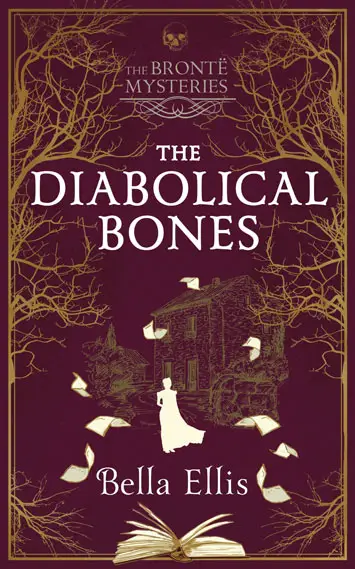The Diabolical Bones by Bella Ellis Review

By Sandra Callard
The Diabolical Bones by Bella Ellis is the second in her series of The Brontë Mysteries. In this book the three Brontë sisters, Charlotte, Emily and Anne, are depicted as detectives solving mysteries in and around the area of Howarth in Yorkshire where they lived.
This may come as a shock to dedicated readers of the Brontës’ books, and it does, in fact, take some time to assimilate this fact. However the style and power of the writer is apparent and the book gathers pace and acceptance as it progresses. The plot is based on the finding of a child’s bones, and the sister’s efforts to find a name for the child and to give it a decent burial. Ellis’s prose flows effortlessly, and it is this that saves the book and allows people to continue reading.
This quest turns up various clues which are the result of the sisters’ detecting and which enters the dubious world of fortune telling, witches and eventually horror, devils and ghosts. This is where the reader either stops reading, ploughs on just to discover the ending, or happily carries on reading however unbelievable the story is becoming.
 Along with the unexpected additional careers the Brontës have pursued, the three writer/detectives have each developed a distinct personality: Charlotte is clever, a society climber and brave. Emily is outspoken, rude and brave and Anne is angelic, beautiful and brave. The early chapters are wordy to excess, as the characters, in true early Victorian speech, will never use one word when twenty will do.
Along with the unexpected additional careers the Brontës have pursued, the three writer/detectives have each developed a distinct personality: Charlotte is clever, a society climber and brave. Emily is outspoken, rude and brave and Anne is angelic, beautiful and brave. The early chapters are wordy to excess, as the characters, in true early Victorian speech, will never use one word when twenty will do.
“Circuitous plot”
The trio fear nothing, not even a depth-of-winter trek through the snow to Top Withens, an actual locality on the moors outside Haworth, bleak and lonely, and a tough climb even in summer. Thought to be the inspiration for Anne’s novel Wuthering Heights, their ability to achieve this arduous task without falling victim to pneumonia lies uneasily with their known poor health and early deaths.
The early chapters of the book take some assimilation, and some effort is required to abandon the accepted stereotypes of the sisters, and to concentrate on the book and the plot. Once done, the later chapters become enjoyable and a little quirky as the plot develops with both danger and humour. The sisters’ brother, Branwell, is also there, offering a dry humour alongside his alcoholism, which actually creates a pleasing and singular diversion to the plot.
Ellis’s writing flows beautifully. The book gathers pace as the ‘detectors’, which the women like to be called, become more involved in the circuitous plot and the eventual outstanding denouement, which is one of the best and most unexpected I have come across recently.
However, Bella Ellis’s venture into this area is fraught with danger. Brontë aficionados will perhaps be horrified, others will read it for fun, and some will thoroughly enjoy it. Whether these Yorkshire literary icons should be resurrected in this way remains controversial – but there can be no doubt this is an entertaining read.
‘The Diabolical Bones’ by Bella Ellis is published by Hodder & Stoughton, £14.99 hardback









